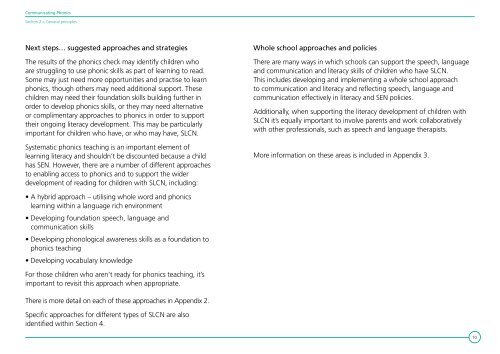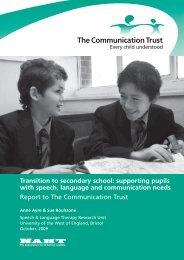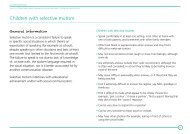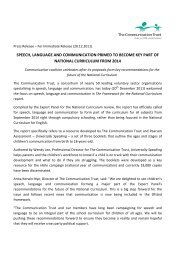Communicating Phonics - The Communication Trust
Communicating Phonics - The Communication Trust
Communicating Phonics - The Communication Trust
You also want an ePaper? Increase the reach of your titles
YUMPU automatically turns print PDFs into web optimized ePapers that Google loves.
<strong>Communicating</strong> <strong>Phonics</strong>Section 2 > General principlesNext steps… suggested approaches and strategies<strong>The</strong> results of the phonics check may identify children whoare struggling to use phonic skills as part of learning to read.Some may just need more opportunities and practise to learnphonics, though others may need additional support. <strong>The</strong>sechildren may need their foundation skills building further inorder to develop phonics skills, or they may need alternativeor complimentary approaches to phonics in order to supporttheir ongoing literacy development. This may be particularlyimportant for children who have, or who may have, SLCN.Systematic phonics teaching is an important element oflearning literacy and shouldn’t be discounted because a childhas SEN. However, there are a number of different approachesto enabling access to phonics and to support the widerdevelopment of reading for children with SLCN, including:Whole school approaches and policies<strong>The</strong>re are many ways in which schools can support the speech, languageand communication and literacy skills of children who have SLCN.This includes developing and implementing a whole school approachto communication and literacy and reflecting speech, language andcommunication effectively in literacy and SEN policies.Additionally, when supporting the literacy development of children withSLCN it’s equally important to involve parents and work collaborativelywith other professionals, such as speech and language therapists.More information on these areas is included in Appendix 3.• A hybrid approach – utilising whole word and phonicslearning within a language rich environment• Developing foundation speech, language andcommunication skills• Developing phonological awareness skills as a foundation tophonics teaching• Developing vocabulary knowledgeFor those children who aren’t ready for phonics teaching, it’simportant to revisit this approach when appropriate.<strong>The</strong>re is more detail on each of these approaches in Appendix 2.Specific approaches for different types of SLCN are alsoidentified within Section 4.10
















